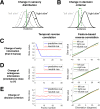Stimulus expectation alters decision criterion but not sensory signal in perceptual decision making
- PMID: 29213117
- PMCID: PMC5719011
- DOI: 10.1038/s41598-017-16885-2
Stimulus expectation alters decision criterion but not sensory signal in perceptual decision making
Abstract
Humans are more likely to report perceiving an expected than an unexpected stimulus. Influential theories have proposed that this bias arises from expectation altering the sensory signal. However, the effects of expectation can also be due to decisional criterion shifts independent of any sensory changes. In order to adjudicate between these two possibilities, we compared the behavioral effects of pre-stimulus cues (pre cues; can influence both sensory signal and decision processes) and post-stimulus cues (post cues; can only influence decision processes). Subjects judged the average orientation of a series of Gabor patches. Surprisingly, we found that post cues had a larger effect on response bias (criterion c) than pre cues. Further, pre and post cues did not differ in their effects on stimulus sensitivity (d') or the pattern of temporal or feature processing. Indeed, reverse correlation analyses showed no difference in the temporal or feature-based use of information between pre and post cues. Overall, post cues produced all of the behavioral modulations observed as a result of pre cues. These findings show that pre and post cues affect the decision through the same mechanisms and suggest that stimulus expectation alters the decision criterion but not the sensory signal itself.
Conflict of interest statement
The authors declare that they have no competing interests.
Figures






References
Publication types
MeSH terms
LinkOut - more resources
Full Text Sources
Other Literature Sources

